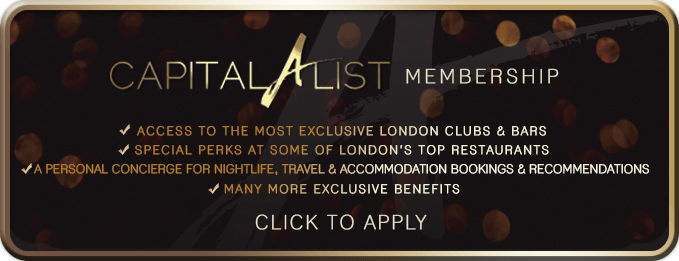Capital A List Membership includes access to exclusive clubs, bars, events and priority restaurant bookings in addition to many other benefits. For more information, please visit Capital A List Membership.
London Luxury Department Stores are more than just shopping destinations—they are cultural landmarks, architectural icons, and immersive experiences that capture the spirit of the city. Each one tells its own story, from historic institutions that have shaped Britain’s retail heritage to bold modern spaces that redefine what luxury shopping can be.
The timeless grandeur of Harrods, the artistic intimacy of Liberty, and the avant-garde creativity of Dover Street Market — these venues combine world-class design, carefully curated collections, and impeccable service in a way that makes every visit feel unforgettable.
In this guide, we highlight the very best department stores in London—each with its own character, history, and allure—that continue to set the standard for luxury retail worldwide.
Harrods
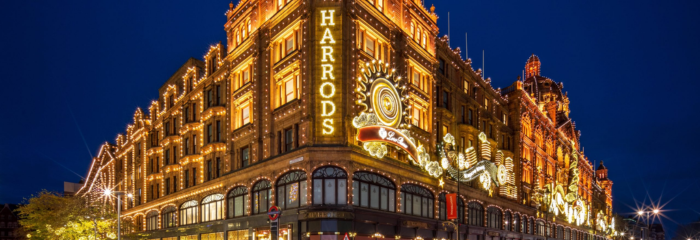
Harrods is less a store and more a kingdom of luxury, stretching across a million square feet of Knightsbridge real estate. Its 330-plus departments cover everything from haute couture and fine jewellery to gourmet food halls that feel like theatres of indulgence. Walking through its marbled aisles, one senses both grandeur and a surprisingly playful spirit—this is where you can buy a custom diamond watch and, a few steps away, a hamper filled with artisan chutneys.
The story began in 1849 as a humble grocery, later reborn on Brompton Road. Even a fire in 1883 couldn’t stop Harrods. The store famously completed its Christmas orders that year and still turned a profit—a resilience that built its reputation. The present landmark building, designed by C. W. Stephens, opened in 1905, featuring a breathtaking Baroque façade and pioneering innovations like England’s first escalator in 1898—complete with brandy for nervous customers at the top.
Today, its motto “Omnia Omnibus Ubique”—“all things for all people, everywhere”—still rings true. Yet, modern refurbishments, from revamped womenswear to David Collins Studio’s food hall redesign, ensure Harrods never feels stuck in the past.
Inside, Harrods is a world unto itself. Find more than 330 departments across 1.1 million square feet of retail space. It is by far Europe’s largest department store. You can browse haute couture, opulent beauty lines, fine jewellery and watches, bespoke stationery, furniture, and a Food Halls experience that’s theatrical in its richness.
Website: Harrods
Address: 87-135 Brompton Rd, London SW1X 7XL
Liberty London
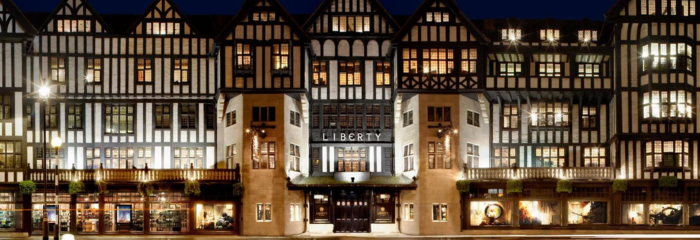
Step off Regent Street into Liberty and suddenly you’re in another world. Its half-timbered Tudor façade, built in 1924 from the timbers of two 19th-century ships, rises like a manor in the West End. Inside, three soaring atriums with carved wood galleries create an atmosphere that’s more stately home than department store.
Arthur Lasenby Liberty opened his original “Oriental warehouse” in 1875, filled with silks and exotic treasures. By the turn of the century, Liberty was a tastemaker, synonymous with Art Nouveau. So much so that in Italy, the movement was nicknamed Stile Liberty. It played a pivotal role in promoting Art Nouveau and Arts & Crafts design. The place received admiration from artists and intellectuals like Oscar Wilde, who famously called Liberty “the chosen resort of the artistic shopper”.
Today, Liberty is celebrated for its exclusive fabrics and floral prints. But its mix goes far beyond: luxury fashion, beauty, and homeware sit side by side with artisanal curiosities. The store also enjoys a unique bond with Japan, a 150-year relationship that includes specialised fabric collections for the Japanese market, continued massive fabric sales, and representation of the UK at Expo 2025 in Osaka.
In essence, Liberty London made the list because it is not just a store—it’s a cultural institution. Its fusion of historical charm, design innovation, curated exclusivity, and creative legacy makes it one of London’s most evocative and beloved luxury destinations.
Website: Liberty London
Address: Regent St., Carnaby, London W1B 5AH
Fortnum & Mason
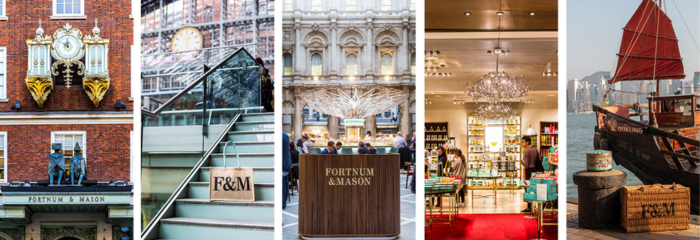
Few stores embody British refinement as effortlessly as Fortnum & Mason. Its green awnings on Piccadilly, the elegant clock with William Fortnum and Hugh Mason striking the hour, and its red-carpeted staircases all whisper timeless charm.
But before the grandeur, there was clever practicality: William Fortnum, once a royal footman, sold spare candle wax from Queen Anne’s court in 1707. From that small profit bloomed a grocer famed for luxuries and innovations like the Scotch egg, created here in 1738. By the 19th century, its hampers were being dispatched with soldiers to the front lines, weaving the brand into Britain’s cultural fabric.
Today, the ground floor remains a temple of gourmet indulgence: teas, preserves, chocolates, and hampers stacked like objets d’art. Upstairs, restaurants, bars, and tearooms extend the ritual. Modern expansions to Heathrow, St Pancras, and even Hong Kong show how this 300-year-old store continues to evolve.
Fortnum’s is where heritage meets indulgence, a place where shopping feels ceremonial, celebratory, and unmistakably British.
Website: Fortnum & Mason
Address: 181 Piccadilly, London W1A 1ER
Harvey Nichols
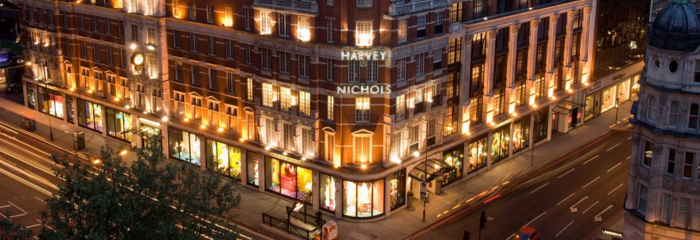
Unlike the stately gravitas of Harrods or Fortnum’s, Harvey Nichols has always been the cool kid on the block, and one of the best London luxury department stores.
The story started far earlier, in 1831, with Benjamin Harvey’s linen shop, which James Nichols later expanded into a full department store. By the 1890s, architect C. W. Stephens had given it a bold new building, the same creative mind behind Harrods. Today, its floors are a tightly edited showcase of international fashion, beauty, and accessories, curated with an eye for what’s next rather than what’s obvious.
Inside, Harvey Nichols offers a carefully curated luxury experience across fashion, beauty, and gastronomy. Its flagship Knightsbridge store is celebrated for its expertly edited designer collections—from Saint Laurent and Loewe to Totême—paired with acclaimed beauty halls and in-house eateries. The fifth-floor Food Hall, once famed for its cheese, tea, smoked fish, and elegant café space, is especially evocative.
In the 1990s, under visionary buyers, the place became synonymous with emerging designers and cultural cachet. Think the Absolutely Fabulous era, avant-garde window displays, and being the first to champion names like Stella McCartney and Donna Karan. Those creative roots remain critical as the store undergoes a modern revival under new CEO Julia Goddard. She brings a strategic vision to refocus, refurbish its layout, and reenergize its identity. The plan is backed by a substantial investment and the appointment of its first-ever creative director, Kate Phelan.
Harvey Nichols makes this list because it represents London’s forward-looking side of luxury retail: smart, curated, stylish, and culturally tuned-in. It’s where you go not just to shop but to see what’s next.
Website: Harvey Nichols
Address: 109-125 Knightsbridge, London SW1X 7RJ
Dover Street Market
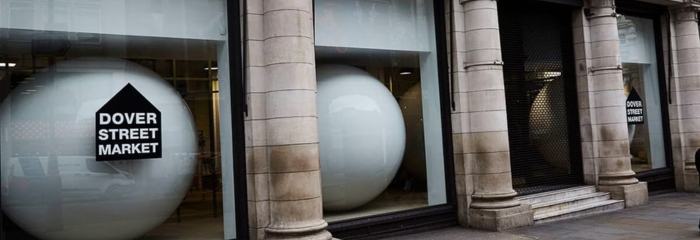
What makes Dover Street Market (DSM) unlike any other luxury destination is the feel of wandering through a living gallery. Think vanguard fashion, avant-garde installations, and the thrill of unanticipated discovery. Founded in September 2004 by Rei Kawakubo (Comme des Garçons) and her partner Adrian Joffe, DSM sprang to life in Mayfair’s Dover Street. Their vision: a “beautiful chaos,” merging high fashion with streetwear, curated brands, and creative expression under one roof.
In 2016, the store made a bold move to a Grade-II listed former Burberry headquarters on Haymarket—adding an architectural theatre to its identity. Spread across five floors connected by a dramatic staircase, each level feels like stepping into a new exhibition; displays are in constant flux, reshaping the space and your expectations.
Inside, DSM is a curated mosaic: you’ll browse labels like Comme des Garçons (in all its lines), Balenciaga, Loewe, Rick Owens, Supreme, and Junya Watanabe, each showcased within bespoke “shop-in-shop” setups by the brands themselves. Art installations—an oversized octopus winding through a staircase, a towering “Frozen Waterfall” of LEDs—add an otherworldly touch to the experience.
Why it’s one of London’s best luxury stores? DSM redefines retail as culture, bringing together emerging designers and established names, retail and art, in an ever-evolving, inspiring environment.
Website: Dover Street Market
Address: 18-22 Haymarket, London SW1Y 4DG
Selfridges
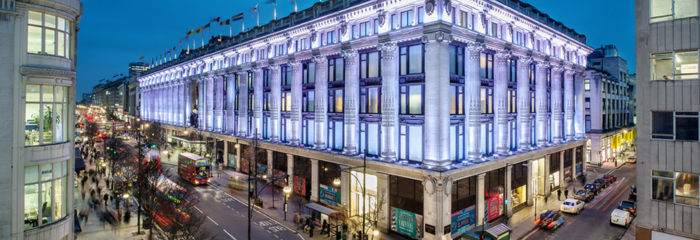
Long before influencer culture or experiential pop‑ups, Selfridges transformed shopping into spectacle. From the moment Harry Gordon Selfridge—a charismatic American executive turned entrepreneur—opened the flagship on Oxford Street in 1909, the phrase “shopping as pleasure, not necessity” became his guiding credo. He envisioned a department store that felt like a civic centre, complete with live music, a reading library, a rooftop garden, and even an American-style soda fountain.
The store’s architecture reflects that ambition. Designed by Daniel Burnham and opened in March 1909, Selfridges’ Beaux-Arts façade hides a sprawling interior of five shopping floors and multiple basements—making it the second-largest store in the UK after Harrods.
Today, stepping inside feels like entering a sensory extravaganza. The escalators pulse beneath dynamic installations and window displays. The beauty hall, the world’s largest and most profitable, dazzles with its curated offerings. Meanwhile, the Wonder Bar lets you sample cognac or wine from a “wine jukebox,” and bespoke services—from private shopping suites to pop-up exhibits—reinforce the store’s legacy of immersion and innovation.
More than just shopping, Selfridges remains a stage—where creativity, design, and experience converge. It continues its founder’s legacy by fostering cultural moments, sustainability initiatives like RESELFRIDGES, and even ventures into the metaverse—all while staying rooted in that original spirit of wonder.
Website: Selfridges
Address: 400 Oxford St, London W1A 1AB
Heal’s
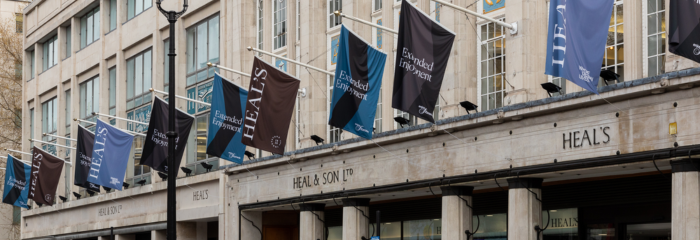
You step onto Tottenham Court Road, and there’s Heal’s: a landmark with a storied façade and an interior that feels both historic and current. Its famous Cecil Brewer spiral staircase—restored in 2013 and now illuminated by a Bocci chandelier—draws your gaze upward. But the building you see is just the latest chapter in a centuries-long narrative. Founded in 1810 by John Harris Heal as a feather‑dressing mattress business, the store migrated from Rathbone Place to Tottenham Court Road by 1818 and eventually into a grand Venetian Palazzo–style building designed in 1854.
What makes Heal’s truly exceptional? Under the leadership of Sir Ambrose Heal (chairman from 1913 to 1953), the company championed the Arts & Crafts aesthetic and mid-century Modernism—introducing Bauhaus and Art Deco pieces to British homes. Its Mansard Gallery even hosted Modigliani exhibitions, blending retail with avant-garde culture.
Today, Heal’s remains a design destination—not just for furniture but for ideas. It continues its legacy with the annual Heal’s Discovers initiative, spotlighting emerging talent like Sebastian Cox and Anthony Dickens. Heal’s is where British retail and design coalesce. It’s both a museum and a showroom, balancing heritage craftsmanship and modern vision. Shopping here isn’t just browsing—it’s engaging with a living design history.
Website: Heal’s
Address: 196 Tottenham Ct Rd, London W1T 7LQ
John Lewis & Partners

If you know London, you know John Lewis—but it’s more than a familiar name; it’s a civic cornerstone built on principles as lasting as its iconic Oxford Street flagship. It’s one of the best London luxury department stores. This revered department store began its journey in 1864 when John Lewis opened a drapery shop at the very site where his boundless vision would unfold. Today, that location remains the flagship of a beloved British retail institution.
What sets John Lewis & Partners apart is its unique ownership model. In 1929, John Spedan Lewis reimagined the company as a partnership held in trust for its employees—now called “Partners”—who share in its rewards and governance. This early experiment in inclusive business still defines its culture and purpose.
Walking through the flagship, you’ll feel the restraint of refined design: clean signage, open-plan interiors, and thoughtful layouts that guide you from fashion to homewares, electronics, and beyond. Recent refurbishments—like an updated beauty hall and multiple dining and wellbeing innovations including a Jamie Oliver Cookery School—signal a modern revival while respecting its classic ethos.
Moreover, the brand remains deeply woven into British life: whether it’s the cherished “Never Knowingly Undersold” promise (reimagined in recent years), or the annual Christmas advert that now marks the start of the festive season, John Lewis continues to shape retail and culture. John Lewis & Partners is where heritage meets purposeful progress. It’s not just one of London’s best department stores—it’s a trusted and evolving institution, blending stability, thoughtfully curated service, and continuous reinvention under one trusted roof.
Website: John Lewis & Partners
Address: 300 Oxford St, London W1C 1DX
The Royal Exchange
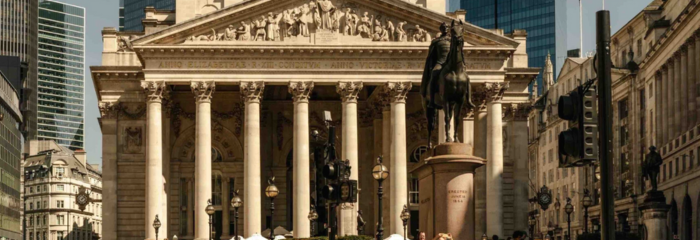
There’s no mistaking The Royal Exchange for your typical department store. Luxuriating beneath its glass atrium and surrounded by majestic neoclassical architecture, the atmosphere hums with centuries of commerce, reinvention, and ceremonial importance.
Established in 1571 by Sir Thomas Gresham—and inaugurated by Queen Elizabeth I—the Exchange was envisioned as London’s dedicated trading hub, inspired by the bustling bourses of Antwerp. Over time, it earned its role as a key site for public proclamations, making it a civic as well as a commercial cornerstone.
The building you experience today is the third iteration—rebuilt in the 1840s after two devastating fires—designed by Sir William Tite in a trapezoidal layout around a central courtyard. Queen Victoria re-opened it in 1844, complete with terraces, Corinthian columns, and the legendary Grasshopper weathervane—salvaged from the earlier blaze.
By the 21st century, it had evolved from a trading house into an architectural gem hosting luxury boutiques and refined eateries. In 2001, it was transformed into a high-end retail and dining address, introducing brands like Hermès and Fortnum & Mason’s bar, all integrated within the historic colonnade and its murals. The Royal Exchange is a theatrical fusion of macro-scale design, ceremonial gravitas, and discreet luxury.
Website: The Royal Exchange
Address: Royal Exchange, London EC3V 3LL
Battersea Power Station
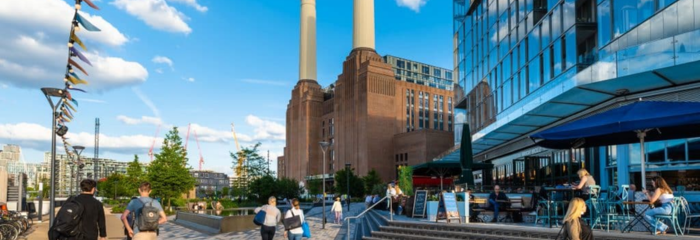
You walk in and realise you’re not in an ordinary shopping centre—you’ve entered an architectural marvel. Formerly an iconic power-generating machine built by Sir Giles Gilbert Scott and J Theo Halliday between 1929 and 1955, Battersea Power Station has been reborn as a high-end retail refuge while retaining its industrial grandeur.
Inside, the lofty turbine halls—Turbine A and B—are now alive with over 150 shops, restaurants, bars, entertainment venues, and lifestyle experiences. Think Breitling, Nike, Mulberry, along with beauty stalwarts like MAC, Jo Malone London, Aesop, and Chanel Beauty—all grounded in that cathedral-like shell of giant gantries and soaring windows. There’s even a dedicated boutique for Battersea’s own story, featuring gifts and memorabilia at Lift 109—an observation platform housed in a refurbished chimney, offering views of London.
But it’s not mere commercial real estate—this is urban theatre. The building’s brick-clad façades and soaring atria preserve its power-station soul, while the sleek architecture by WilkinsonEyre transforms it into a dramatic retail and cultural stage. The Northern line extension, opening in 2021, brings effortless access, weaving the venue into the city’s fabric like never before.
Why is it one of London’s most exceptional “stores”? Because it transcends the concept of shopping. Battersea Power Station is a living monument—its industrial past reinvented as a modern destination where every step—from browsing boutiques to sipping cocktails—feels as epic as the space that wraps around it.
Website: Battersea Power Station
Address: Circus Rd W, Nine Elms, London SW11 8DD
Currently Featured
From Michelin Excellence to the Roux Brothers and Pierre Koffmann, Chef Sameer Taneja’s Benares: A Journey Back Home

What a journey this guy’s been on. I had the chance to sit down with Chef Sameer Taneja, the executive chef at Benares in Berkeley Square. You’d expect a Michelin-starred chef with his CV to be all puffed up with self-importance, but not Sameer. He’s not the type to humble brag with his hand earnestly resting on his chest, telling you ‘how grateful and humbled’ he is in that way that makes you cringe. No, […]
Blue Marlin Ibiza Club London

Blue Marlin Ibiza Member’s Club in London is part of the club’s extensive portfolio. Known for its elegant beach clubs in Ibiza and other international locations, Blue Marlin is a reference for luxury and the joy of celebrating life’s pleasures. Located at the Mondrian Shoreditch on Curtain Road, their London venue is a slice of Ibiza’s famed party atmosphere in the East End. The Blue Marlin Ibiza in London aims to create a haven of […]
Mosimann’s – A Look Inside London’s Famous Members Restaurant
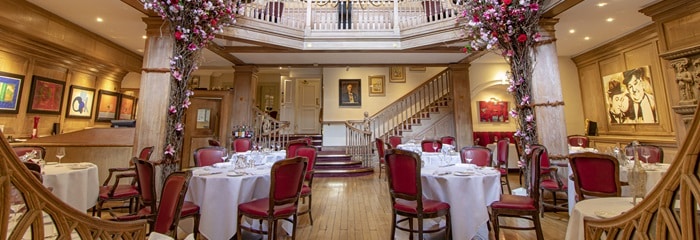
When one utters “Darling… I’m just popping in for a spot of lunch at a luxurious dining restaurant in Belgravia that catered to both Harry and William’s wedding; it has John Major, John Cleese and a long list of actors, writers, and politicians as regulars too. The rub is that you must be a member to even order a starter, and it catered for the Olympics, US presidents and some of the most powerful people […]
